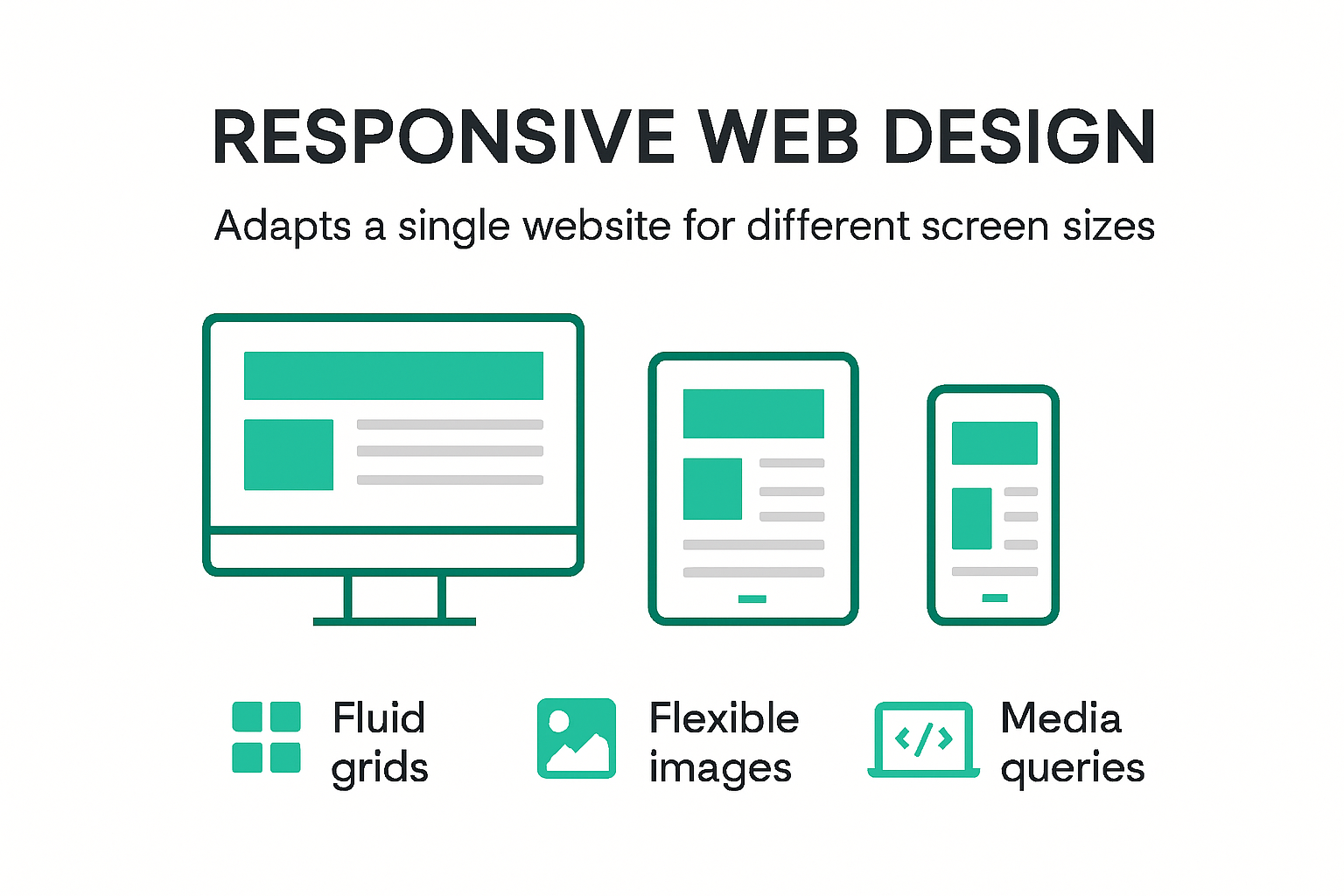 Responsive web design is now a survival skill for small businesses. More than 50 percent of all internet traffic in 2025 comes from mobile devices. That might sound like an exciting tech milestone. Yet here’s the twist. Skipping out on a mobile-ready site could be quietly costing your business customers every single day.
Responsive web design is now a survival skill for small businesses. More than 50 percent of all internet traffic in 2025 comes from mobile devices. That might sound like an exciting tech milestone. Yet here’s the twist. Skipping out on a mobile-ready site could be quietly costing your business customers every single day.
Table of Contents
- What Is Responsive Web Design Explained Simply
- Why Responsive Design Matters For Small Businesses
- Key Features And Tools For Service-Based Sites
- Steps To Make Your Website Responsive In 2025
Quick Summary
| Takeaway | Explanation |
|---|---|
| Responsive web design is essential for small businesses | A unified website optimizes user experience across devices, enhancing customer engagement and credibility. |
| Mobile-first design approach is crucial | Prioritizing mobile needs leads to streamlined content and navigation, making sites more efficient and user-friendly. |
| SEO benefits from responsive design | Mobile-optimized websites rank better in search results, increasing visibility and potential business growth. |
| Cost-effectiveness of a single responsive site | Managing one responsive website is more cost-efficient than maintaining multiple versions, saving time and resources. |
| Ongoing optimization is necessary | Continuous testing and refinement of responsive features ensure websites adapt to evolving user needs and technologies. |
What Is Responsive Web Design Explained Simply
Responsive web design is a strategic approach that ensures websites look great and function perfectly across all devices, from smartphones to desktop computers. At its core, responsive web design creates a flexible digital experience that adapts seamlessly to different screen sizes and device capabilities.

The Fundamental Concept of Adaptive Websites
Responsive web design works like a digital chameleon, dynamically adjusting website layouts and content to provide an optimal viewing experience. According to Nielsen Norman Group, the key principle is creating websites that automatically resize, reorganize, and reformat content based on the specific device being used.
Small business owners need a website that works everywhere without creating multiple versions. This approach means one website serves smartphone users, tablet readers, and desktop visitors equally well. By digital.georgia.gov, adopting responsive design eliminates the need for separate mobile versions, simplifying content management and reducing development costs.
Technical Elements Making Responsiveness Possible
Three primary technical components make responsive web design function:
- Fluid Grids: Layouts that use relative units like percentages instead of fixed pixels, allowing content to scale proportionally
- Flexible Images: Graphics and media that resize automatically without losing quality or breaking page layout
- CSS Media Queries: Technical rules that detect device screen size and apply appropriate styling
The World Wide Web Consortium (W3C) recommends these techniques to create websites that provide consistent user experiences across different devices. For small businesses, this means creating a professional online presence that looks polished whether someone visits from a phone or computer.
Why Responsive Design Matters for Business
Website performance directly impacts business success. Google’s research shows that 53% of mobile users abandon websites that take longer than three seconds to load. Responsive design addresses this by optimizing page speed and user experience across all devices.
For small businesses, a responsive website is no longer optional. It represents a critical tool for reaching customers, building credibility, and competing effectively in the digital marketplace. When your website looks professional and functions smoothly on any device, you create a positive first impression that can translate into increased customer engagement and potential sales.
Why Responsive Design Matters for Small Businesses
Small businesses operate in a digital ecosystem where online presence can make or break success. Responsive web design has transformed from a trendy option to a critical business strategy that directly impacts customer engagement, search visibility, and overall digital performance.
The Mobile-First Reality for Small Business Websites
Small Business Trends reveals a pivotal statistic that demands attention: mobile devices now account for more than 50% of global internet usage in 2025. This shift means small businesses cannot afford to ignore mobile optimization. Customers expect seamless experiences across smartphones, tablets, and desktops.
When a website fails to function properly on a mobile device, potential customers quickly navigate away. Research shows that 57% of users will not recommend a business with a poorly designed mobile website. For small businesses competing against larger competitors, every interaction counts. A responsive design ensures your digital storefront looks professional and functions smoothly, regardless of the device used.
Search Engine Visibility and Business Growth
Google’s algorithm prioritizes mobile-friendly websites in search rankings. This means responsive design is not just about aesthetics but directly impacts your business’s online discoverability. Small businesses can level the playing field by implementing a responsive website that meets modern search engine standards.
Consider these key advantages:
- Improved Search Rankings: Websites optimized for mobile receive preferential treatment in search results
- Enhanced User Experience: Visitors stay longer on sites that work smoothly across devices
- Increased Conversion Potential: A seamless browsing experience translates to more customer interactions
Cost-Effective Digital Strategy
Next Gov research highlights that maintaining a single responsive website is significantly more cost-effective than managing multiple device-specific versions. Small businesses can save substantial time and resources by adopting a unified web design approach.
Traditional web development required separate mobile and desktop sites, multiplying design, maintenance, and update costs. Responsive design eliminates these redundancies. One website adapts automatically, reducing development expenses and simplifying content management. This efficiency allows small business owners to focus on core operations rather than complex web technical challenges.
The digital landscape continues evolving rapidly. Responsive web design represents more than a technical solution it is a strategic investment in your business’s online success. By prioritizing a flexible, user-friendly website, small businesses can create compelling digital experiences that attract, engage, and convert potential customers across all devices.
Key Features And Tools For Service-Based Sites

Service-based businesses require responsive websites that not only look professional but also effectively communicate their unique value proposition across all devices. Understanding the right features and tools can transform a basic website into a powerful marketing and customer engagement platform.
Essential Design Features for Service Websites
Wikipedia’s responsive web design overview highlights three critical technical components that service businesses must prioritize: flexible grids, adaptable images, and strategic media queries. These elements ensure your website looks polished and functions smoothly on smartphones, tablets, and desktop computers.
For service-based sites, certain design features become paramount. Contact forms must be easily readable and fillable on smaller screens. Service descriptions should adjust dynamically, maintaining readability without overwhelming mobile users. Navigation menus need to collapse or transform into mobile-friendly hamburger menus that remain intuitive and accessible.
Here is a table summarizing the essential design features for service-based websites and their benefits:
| Feature | Description | Benefit |
|---|---|---|
| Flexible Grids | Layouts scale with relative units (percentages) | Consistent look across all devices |
| Adaptable Images | Media resizes automatically for different screens | Maintains graphic quality and layout |
| Contact Forms | Easy to read and fill on mobile devices | Higher lead conversion and usability |
| Dynamic Service Descriptions | Content adapts for readability on any device | Clear info without overwhelming the user |
| Responsive Navigation | Menus collapse/transform (e.g., hamburger menu) for mobile devices | Smooth navigation on all screen sizes |
Strategic Tools for Responsive Development
Harvard Media research indicates that implementing the right development tools can significantly reduce bounce rates. CSS frameworks like Bootstrap and Foundation provide predefined fluid grid systems that streamline responsive design development.
Key tools service businesses should consider include:
- Responsive Framework Libraries: Accelerate development with pre-built responsive components
- Mobile-First Design Platforms: Prioritize mobile user experience from the initial design stage
- Performance Testing Tools: Ensure consistent functionality across different devices and screen sizes
Performance and User Experience Optimization
Mold Studios research emphasizes that responsive design is more than technical implementation. It is about creating seamless user experiences that adapt to user needs.
Service-based businesses should focus on:
- Fast Loading Times: Optimize images and minimize code to ensure quick page loads
- Clear Call-to-Action Buttons: Make conversion paths obvious and accessible on all devices
- Readable Typography: Use scalable fonts that maintain legibility across different screen sizes
By thoughtfully implementing these features and tools, service-based businesses can create responsive websites that not only look professional but also effectively convert visitors into customers. The goal is to provide a consistent, high-quality digital experience that reflects the quality of your services.
Steps to Make Your Website Responsive in 2025
Transforming your website into a responsive digital platform requires strategic planning and technical implementation. Small businesses must approach responsive design as a comprehensive process that goes beyond simple resizing and focuses on creating meaningful user experiences across all devices.
Mobile-First Design Strategy
Digital Georgia’s web standards recommend starting with a mobile-first design approach. This methodology means designing for the smallest screen sizes first and progressively enhancing the layout for larger screens. By prioritizing essential content and functionality, businesses create cleaner and more efficient websites.
Mobile-first design involves:
- Prioritizing Core Content: Identify and highlight the most critical information for mobile users
- Simplified Navigation: Create intuitive, streamlined menus that work seamlessly on touch screens
- Performance Optimization: Minimize unnecessary elements that could slow down mobile loading
Technical Implementation of Responsive Layouts
CSS Grid and Flexbox technologies provide powerful tools for creating flexible, adaptive layouts. These modern CSS techniques allow developers to design fluid grid systems that automatically adjust to different screen sizes and orientations.
Key technical steps include:
- Use Relative Units: Replace fixed pixel measurements with percentages and viewport units
- Implement Media Queries: Create specific style rules that activate at different screen width breakpoints
- Test Across Multiple Devices: Verify responsiveness using browser developer tools and physical device testing
Below is a table summarizing the core steps to make a website responsive, along with their goals and examples:
| Step | Goal | Example |
|---|---|---|
| Mobile-First Design | Prioritize mobile experience | Simple menu, fast load on smartphones |
| Fluid Layouts with Relative Units | Adapt to any screen size | Use % and viewport units for widths |
| CSS Media Queries | Apply styles per device/breakpoint | Change columns to stacked on small screens |
| Responsive Images/Media | Optimize visuals for devices | “srcset” for image sizes |
| Performance Optimization | Fast load and smooth UX | Lazy loading, compress images |
| Device Testing & Iteration | Ensure real-world usability | Test with phones, tablets, desktops |
Performance and Media Optimization
Digital Georgia’s guidelines emphasize the critical role of media optimization in responsive design. Large images and unoptimized media can significantly slow down website performance, especially on mobile networks.
Effective optimization strategies include:
- Modern Image Formats: Utilize WebP and AVIF formats for smaller file sizes without quality loss
- Responsive Image Attributes: Use
srcsetto serve different image sizes based on device resolution - Lazy Loading: Defer off-screen images and videos to improve initial page load times
Implementing responsive design is not a one-time task but an ongoing process of refinement. Small businesses must continuously test, analyze user interactions, and adapt their websites to changing technological landscapes. By embracing these steps, you create a digital presence that looks professional, functions smoothly, and provides an exceptional user experience across all devices.
Frequently Asked Questions
What is responsive web design?
Responsive web design is an approach that makes websites function effectively on various devices by automatically adjusting layouts and content based on the screen size and capabilities.
Why is responsive web design important for small businesses in 2025?
With over 50% of internet traffic coming from mobile devices, responsive web design is crucial for small businesses to attract and retain customers by providing a seamless browsing experience across all devices.
How does responsive design impact SEO?
Responsive design improves SEO by ensuring mobile-friendly websites rank higher in search results, leading to better visibility, increased traffic, and potential business growth.
What steps can I take to make my website responsive?
To make your website responsive, implement a mobile-first design strategy, use fluid grids and CSS media queries, optimize images for different devices, and continuously test your website across various platforms.
Ready to Make Your Website Work on Every Device—And Grow Your Business?
Are you struggling because your website looks clunky on phones or loads slowly for customers? The article you just read highlights how skipped steps in responsive web design can quietly turn away potential clients and even affect your search engine rankings. Many small businesses lose leads every day because their site is not optimized for the way real people browse today. You do not have to let technology stand between your services and your customers.

Turn your website into a powerful business tool that performs beautifully everywhere with Finepoint Design. Our team can help you create a single, responsive website that looks clean and loads fast, so you stay ahead of competitors and never miss a customer. If you are ready for higher search visibility, stronger engagement, and a better return on your online marketing, connect with us now. Act now to take the first step toward a website that finally pays off.